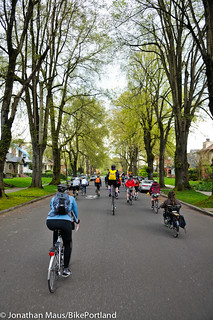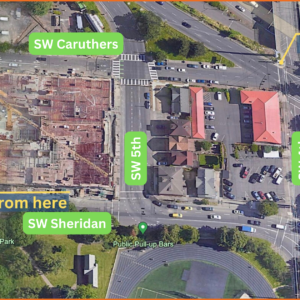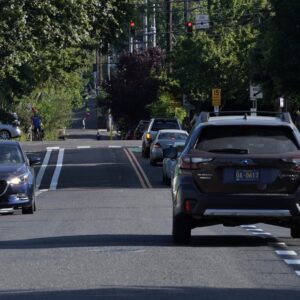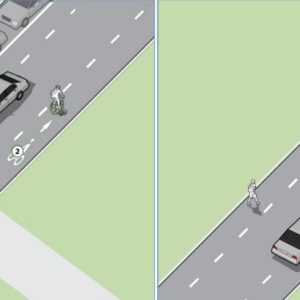One of Portland’s busiest bicycling streets is set for a repaving project next week. The City of Portland says they’ll start work on SE Ladd Avenue between Hawthorne and Division on Monday June 1st and the project will last through Tuesday the 9th.
Be advised of lane closures and detours from 7:00 am to 5:00 pm each week day. The Bureau of Transportation plans to pave 1.78 lane miles off Ladd Avenue — including a complete repaving of Ladd Circle.
Here’s more about the detours and closures from PBOT:
During work hours, SE Ladd Avenue will be open only in one direction, to inbound travel. People traveling towards downtown by bus, motor vehicle and bicycle will be able to share the road during those hours.
Advertisement
For outbound travel, alternate routes will be available. Buses and motor vehicles will be detoured to SE 11th or 20th avenues. People traveling by bicycle may use those alternate routes or neighborhood streets.
During non-work hours, the street will be open to all travelers. Portions of the road will have a rough surface until paving is complete. Access will be maintained for businesses and residents during the project.
PBOT bike counts show that Ladd Avenue gets about 3,00-4,000 daily bike riders.
PBOT says their work schedule could change depending on the weather. They are also reminding everyone to use caution in the area and expect delays during the project.






Thanks for reading.
BikePortland has served this community with independent community journalism since 2005. We rely on subscriptions from readers like you to survive. Your financial support is vital in keeping this valuable resource alive and well.
Please subscribe today to strengthen and expand our work.
Nice smooth roads for all the cut through traffic.
And a whole lot of people biking.
Diverter at Ladd and 12th. Diverter at Ladd and 20th.
12th or 20th is a long way for an older person to walk to catch a bus.
How about smaller local transit vehicles and traffic calming to deter cut-through vehicles?
Not sure what this means. Can you expand? Center of Ladd to its periphery is 400m or so. That’s about what I walk in NE to the bus.
Do you use a cane or walker? How’s your eyesight? Can you walk faster than 2 feet per second?
Actually, at the moment, no, it’s about 2’/sec for me. But back to the point, what does local transit vehicles mean? Smaller buses? Intrigued by the idea.
Yes. choosing vehicles to match the service. Small 20-passenger vehicles for feeder routes to mainlines and light rail. Standard size for mainlines, and articulated BRT or light rail for regional.
Good idea. I’d love if Trimet used smaller vehicles for feeder routes and not just up to the zoo.
Bus-Bike only diverter like at 52nd and Division. If this could get it through engineering, I know whom to talk to spearhead locally….
I like this idea, but I would like to see data on how well it is observed and how it is enforced. The intersection at NE Multnomah and 21st, while it includes “local travel,” has seen a lot of non-local travel IMO.
Diverter at Ladd and Ladd’s Circle on both ends. Bus/bike only, no cars. Use red light enforcement cameras to ticket the offenders.
But! But! That would eliminate the age-old “What about the bus?” excuse!
Hear, hear!
Shame they couldn’t wait until after Tillikum Crossing opens.
They just repaved SE Ladd within the last 5-10 years, does it really need to be done again this soon?
Probably wouldn’t be if PBOT and Trimet could just get together to move the 10 bus off of Ladd’s. Mixing buses and bikes in shared space is not a best practice.
Off topic. It’s not the ‘mixing’ of bikes and buses that causes the road to be repaved, it’s the weight of buses that damage roads.
True, but a valid point nevertheless. If Trimet were more flexible in rerouting the 10, Ladd and Clinton would be a lot safer.
If Trimet were more diligent about driver training and listening/responding to customer complaints, it would likewise be a non-issue.
Matt, I think a bigger deal than the objective safety threat from buses (which is not ALL that great IMO compared to all the other motor vehicle traffic on Clinton and Ladd) is the subjective safety problem. Riding a bike next to a bus with no barrier just feels scary. Scary feelings like that are what keep people from riding bikes and walking here as much as they would otherwise, which has huge health impacts, far beyond the impact of crashes. All the driver training and responsiveness in the world won’t make riding a bike next to a bus in shared space a comfortable experience.
Sorry, I was hurrying and didn’t explain fully.
1) The weight of buses causes roads to be repaved more often
2) 10 Bus does not need to be on SE Ladd for city mobility (all of Ladd’s Addition is within walking distance of Division/Hawthorne).
3) Moving bus off of SE Ladd and onto 7th/Division (say) would make there be one less street that needs to be repaved often because of bus loads. (The 4 already goes on 7th/Division with much greater frequency than the 10 has; I bet adding the 10 would only increase the paving frequency on those roads marginally).
4) Moving the 10 off of SE Ladd and onto 7th/Division (say) would have the ancillary benefit of removing bus/bike conflict on SE Ladd. I think TriMet drivers are great, on average. But the fact is that having a bus and a bike share space reduces subjective safety for the people biking considerably, regardless of how well trained the bus drivers are.
“1) The weight of buses causes roads to be repaved more often …” Alex Reed
Ladd’s isn’t a very long street. About seven or eight blocks. Possibly wouldn’t be cost prohibitive to pour this distance of road surface with concrete that stands up to heavy vehicle weights better than does asphalt.
The short distance through Ladd’s could justify reduced posted speed limits through the neighborhood too. Really, 15 mph is fast enough for the seven or eight block distance. That reduced speed for buses especially, would most likely not impact bus schedules appreciably, and would have the buses produce less noise, and pose less danger to vulnerable road users.
The 10 is a symbolic bus line. It goes through Ladd’s to appease the wealthy, influential people who live there. Good luck getting it changed.
A more diverse fleet would be of benefit to the people of Portland. Smaller buses for the low speed and narrow roads. Ever seen TriMet using NE 27th?
The smaller buses end up costing just as much to operate, and they lack capacity and diminish overall fleet flexibility.
Do you have data to back this up?
Yes, everyone knows every wealthy influential person there takes the bus.
Our local bus (the 19) routes through East Moreland sometimes. I’ve always found that a little odd for the same reason.
Well, their servant staff have to get to work somehow too, right? :/
There are plenty of people living in Eastmoreland (self included) who a) appreciate the bus and b) will never, ever be remotely in a position to have servants or do/have any of those other tired rich person cliches.
This does seem completely unnecessary. The road is glass compared to many other busier roads as well as other bike corridors (or even just normal streets in SE). For example, SE Madison in the upper 40’s is atrocious, used by a lot of bikes and was improperly asphalted years ago during sewer work given the road was concrete originally. This is now leading to persistent transition failures. A city engineer even pointed it out to me! And this is just ONE street. Time for PBOT to reset the priorities…
And what about just off the Hawthorne bridge downtown between 1st and 2nd!!!! C’mon PBOT!!!!! Literally a roller coaster of potholes and patches.. No more rich neighborhood BS
Yes! Yes! NE Going comes to mind. Or NW Broadway.
I don’t have any special knowledge of this particular situation, but the cost per foot to resurface goes up pretty rapidly once the street reaches a certain level of disrepair. Then once the street is as bad as it can get, the (high) cost of totally redoing it is pretty much fixed. I had a flyer with cost numbers on it here a few weeks ago… can’t find it now.
They can resurface Ladd today for $10, and have it be in good upkeep until 2020 when they’ll need to spend another $10 on it. Or they can do nothing now, and spend $50 to rebuild it in 2020. All those other streets in really bad shape, like Madison, probably need $50 spent on them, too, but does it make sense to save $10 now, incur $40 later for Ladd, and then still need $40 today plus have to do upkeep later on Madison? Madison needs $50 to fix now, and it’s still going to need $50 to fix in 2020.
To have both Ladd and Madison in good condition in 2020, they can do Ladd now and Madison later and the total cost is $70 (=$10+$10 for Ladd, $50 for Madison). Or they can do Madison now and Ladd later, and the total cost is $110 ($50 now +$10 later for Madison, $50 later for Ladd).
They might only have $10 right now, in which case spending in on Ladd is the better financial choice. And even if they have $50 right now, it’s still not good fiscal policy to neglect Ladd, even though it’s not that bad yet.
Thanks for putting numbers to this. I get what you’re saying, but
I don’t think it is coincidence that the city has let more streets in outer neighborhoods crumble, while spending most of that maintenance money on inner streets.
So the rich streets stay rich and the poor streets stay poor.
One of the big issues should be bus routing, and why so many busses are routed down low volume residential streets (that then require more maintenance).
Hey Dave,
I agree with you that the City has inequitably underinvested in outer eastside neighborhoods in myriad ways, but I actually don’t think road maintenance is one of them (with the giant exception of unpaved roads). Check out the two maps here: https://www.portlandoregon.gov/transportation/65221
I can’t parse out a clear pattern from those maps and tables, aside from Southeast Uplift getting the short end of the stick. And I’d call SEUL 50% “inner”, 40% “mid”, and 10% “outer”, so that doesn’t seem like an equity affront to me.
Don’t get me wrong, the historic lack of investment in paving unpaved roads, bike infrastructure, transit, crosswalks, sidewalks, and so much more in outer Eastside neighborhoods is unconscionable. But perhaps road maintenance is not one of the areas of inequity.
While the economic argument you’ve laid out makes sense, it really shouldn’t be the only criteria, and PBOT’s lack of transparency around that is troubling. Perhaps they do take other criteria into account, overall traffic volume, types of traffic, etc. But we’ll never know. Also, some roads reach such a bad state, they should become eligible for emergency status, where cost is no factor, such as SW Main between 1st and 2nd.
Warning to all pedalpalooza ride leaders is advised as this is a popular route.
Does anyone know if PBoT has considered any striping or other modifications to update the operations/ design/ safety of the route?
I would start with:
– adding a bike refuge island / slot for bicyclists to make a yield right (when pends are present) vs. stop right at the circle;
– raised pedestrian crossings at the motor vehicle intersections at the circle;
– restriping the circle to make it less a rotary and more of a roundabout…and also a public space pedestrians can get to easier;
– I assume the resurfacing work will trigger ADA upgrades; and
– Regional traffic diverter?
Oh, and exchanging stop for yield signs.
haha.
WTH, that road is fine
Seen those ruts south of Clay?
that’s what I was thinking..there are a dozen dirt roads I can think of east of 52nd that need pavement…yet Ladds addition gets it?
Projects like this do (rightly or wrongly) give people a negative impression of PBOT’s priorities and the way it spends its money. And makes it harder for them to ask for more money in the future.
Which is why, for the umpteenth time, I feel like PBOT should get out in front of this easily anticipated criticism/bad press and hang out here for half an hour/week or month to field questions about decisions like this; give us their explanation. Or better yet, when announcing these projects give some context that anticipates the criticisms, nips them in the bud. If they can’t do that, then maybe our critiques are actually correct and they need to reprioritize their schedule of repairs, or stings or whatever.
This will divert me all the way down Clinton to the fluster cluck of crossings at the east end of the Tillicum Bridge.
You might try going south on 10th, east on Market and south on Mulberry to Harrison. Harrison/Cypress/20th will get you to Division. 20th has traffic calming.
The northbound path should be open during the work.
Yup, another in a long list of roads getting repaved that are perfectly fine. I can not understand how this gets a repave while so many really bad streets don’t.
Isn’t the pavement on SE Ladd doing fine?
so drivers should be fine with all the spill-over bike traffic on Division and Hawthorne… right?!
I mean, if it works for drivers then it should work for cyclists…
Why are they paving these streets. They are in much better condition than most. Must be the pull and money that the area has
Maintenance is scheduled for the highest return on investment. Regular maintenance makes roads last longer and costs less over the long term than letting a road go and having to rebuild all of it.
1st and Main already then. One of the most highly trafficked bike spot in the city. Heavy car use, and some of the worst pavement outside of an alleyway.
“Maintenance is scheduled for the highest return on investment.”
Please!
This is so transparently bogus. Even if the economics or engineering underlying this claim are true, it still doesn’t compute that you fix the not very worn streets in rich neighborhoods ahead of the crumbling ones in poor neighborhoods. What if after fixing all the decent-appearing streets there’s no money left to fix the crumbly ones?
Too bad. Maybe next time?
Here’s an example of the problem in reverse:
When I was a kid, my mom always bought the (over-)ripe bananas because they were cheaper. In a given batch there were always some that were mushier than others. We were expected to eat the ripest ones first. By the time we had struggled through those, the ones that had arrived still somewhat firm were also mushy.
Ladd has crumbly parts as well.
So, you don’t maintain the working bikes you own, instead putting all your money into the one that needs to be replaced, and have no money left over to maintain the working ones.
Great plan.
“So, you don’t maintain the working bikes you own, instead putting all your money into the one that needs to be replaced, and have no money left over to maintain the working ones.”
Except that these roads do not belong to Leah Treat; they belong to everyone. That is the difference.
If I were in charge of maintaining a fleet of bikes, to take your analogy, and I kept fixing the people’s bikes who gave me fat tips but never got around to fixing the poor peoples’ bikes how reasonable or fair would that seem?
How is it that people in Ladd’s Addition are tipping bigger than Powellhurst-Gilbert? Much of PBOT’s budget is based on gas tax and parking revenue. Inner east side has the largest bike mode share, outer east the lowest.
Your analogy addendum also forgets that those bikes you describe are shared by the whole city. Ladd serves thousands of cyclists from all over the city, not just the few that happen to own homes that front the street.
So outer east is likely paying more in gas tax, but getting less for it?
And I think 9 was talking more about “influence” than actual money.
Yes. Thanks davemess.
This is such a waste. There are other roads that need to be repaved well before this road. I ride down Ladd’s practically every day. It SO did NOT need to be repaved.